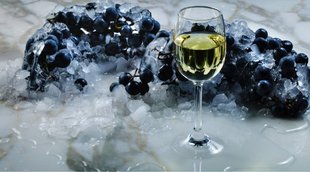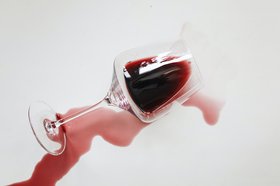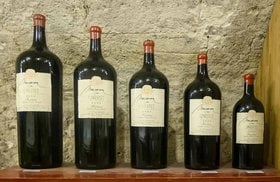Ice Wine (Prices, Tasting Notes, Best Brands 2025)
Curious about ice wine, how it’s made, and the best ones to buy?
From frostbitten grapes in the middle of winter comes this uber sweet wine. Since its invention in Germany, eiswein or ice wine has been lauded for the ingenuity of its makers. Some ice wine bottles also age well for over a decade making it a great addition to your wine cellar.
You’ll come across several bottles labeled as “iced wine” or “icebox wine.” Those aren’t true ice wines though!
Let’s explore all about the best (or true) ice wines, ice wine grape varietals, how the wine is made, and the 10 best ice wines of 2024.
You’ll also discover the best way to invest in authentic, high-quality wines, whether it’s white or red wines, or ice wine.
Further reading
- Explore the winemaking methods for ageworthy Chateauneuf du Pape wines.
- Find out about the elegant Moet Champagnes or the exquisite Viognier wines.
- Discover sweet wines like the cheerful Asti Spumanti.
What Is Ice Wine?
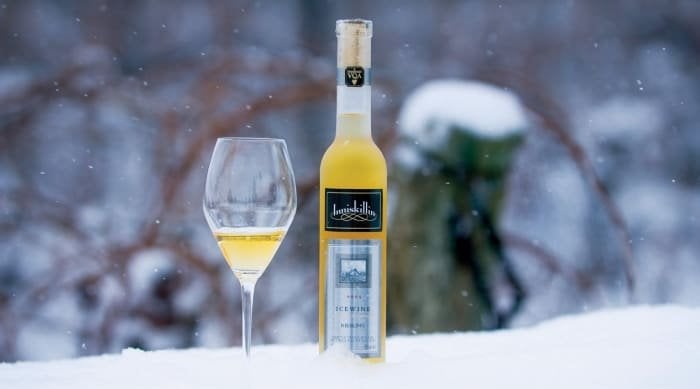
Ice wine or Eiswein (as it’s known in Germany) is a sweet, dessert wine made with partially frozen grape varieties. This causes a high concentration of natural sugar content in the juice that makes the resulting wine high in residual sugar. Almost twice as much as a glass of cola!
Ice wine can be both red or white wine.
The origin and evolution of ice wine can be traced back to the same period as that of sweet wine.
Ice wine’s recorded history began in 1794 at Franconia, Germany. Winemakers in Schloss Johannisberg (in Hesse) woke up to vineyards full of frozen grapes. They went on to press these iced grapes into a concentrated juice to make a sweet wine that quickly became popular.
By the 19th century, German producers had an established tradition of making ice wine made with late harvest grapes.
Over the years, Canada, the USA, several European nations, and Japan also picked up ice wine production. Today, Canada with its long, bitterly cold winters and warmer summers is the biggest ice wine producer in the world, followed by Germany.
France, otherwise the wine capital of the world, produces very little ice wine due to its warmer weather. And most of it comes from the Alsace region.
Explore other French wines in these detailed guides:
- Ultimate Guide To French Wine Regions (2024)
- Montrachet Wine (Best Wines, Prices & How to Buy)
- Dom Perignon Champagne: History, Prices, and How to Buy It
Since ice wine making requires temperatures naturally low enough to cause freezing of grapes, its production is limited to colder countries. Of late, experts have noted the impact of climate change in regions that produce ice wine.
Such limited production quantities (along with a complicated vinification process) is the reason why ice wine is often rare and expensive. Wine lovers need to pay upwards of a hundred dollars for a half bottle.
However, this is true only for “true ice wine!”
What is true ice wine?

Wine can be called ice wine or Eiswein only if the grapes froze naturally on the vines. If the grapes were artificially frozen after harvest, the wine cannot qualify as true ice wine.
All other wines are just known as “dessert wine”, “iced wine”, or simply as table wine. So if you’re looking for authentic ice wine, be wary of these misleading labels.
You can also pick ice wine based on the varietals and regions it’s made in.
Let’s take a look at some of the prominent varietals and where they’re grown.
Ice Wine Varietals

The bouquet of ice wine grapes includes red and white grapes, and is full of regional diversity. Here are some of the most commonly used grapes in ice wine making.
a. Riesling
This French origin grape variety is the most widely planted in Germany, where winemakers have long used it to make some of the most highly valued ice wines of the world. Beyond Europe, Riesling has found a home in other ice wine making countries like the USA and Canada.
b. Vidal
The frost-resistant nature of this aromatic grape makes it an ideal fit for the cold terroir of North America, parts of continental Europe, and Sweden. The Vidal grape (also known as Vidal Blanc) is popular for its distinctive sweetness and its balancing high acidity.
c. Gewürztraminer
This white wine varietal is a challenging crop (vulnerable to frosts) but yields a rewarding eiswein harvest of lychee scented grapes. You can find Gewürztraminer vineyards across Europe, the Americas, New Zealand, and even parts of the Middle East.
d. Other ice wine grapes
Besides the above top tier ice wine varietals, you can also pick ice wine made with the following white and red grape varieties:
- Chardonnay
- Merlot
- Cabernet Franc
- Cabernet Sauvignon
- Chenin Blanc
- Pinot Noir
- Pinot Gris
- Pinot Blanc
This family of ice wine grapes keeps expanding as winemakers experiment with new varietals every year.
How Is Ice Wine Made?
Although the winemaking process differs slightly from region to region, most ice wines share a few things in common.
Check out the main steps of ice wine making:
Viticulture

Ice wine grapes stay on the vine longer than most others, awaiting the frosty winters. And the longer they stay on the branch, the sweeter they become.
During this time, farmers try their best to protect them from the onset of noble rot or the botrytis cinerea fungus. Only ‘clean’ grapes, free from botrytis, make it into the wine.
Harvesting these grapes is extremely tricky. If winter sets in too early, the juice will not be sweet enough to make good wine. And if it happens too late, the fruit will begin to rot.
That’s why vineyard owners must prepare themselves for quick decisions. The final ice wine harvest takes place in the early morning hours at freezing, sub-zero temperatures!
These hand-picked grapes are stored (only briefly) at very low temperatures to protect them from spoiling before the pressing process.
Pressing and fermentation
Winemakers instantly press the harvested grapes. If the temperatures are too low, this can sometimes be a tall order as it can damage the pressing equipment also.
If it’s not “true ice wine”, a vintner can freeze the healthy grapes after harvest and then press them. This is known as cryoextraction.
In either case, the low temperatures and high sugar content slow down the fermentation process. It can take anywhere between three to six months for the sweet juice to fully ferment.
Regional variations

Canadian Ice Wine
Artificially frozen wines are known as “icebox wines.”
Canada (the biggest producer of ice wine), Germany, the USA, and Austria have strict regulations about only allowing naturally frozen grapes for ice wine. In Germany, winemakers are expressly prohibited from freezing grapes post-harvest.
Most ice wines have low alcohol levels of around 6%. This is because the excess sugar ferments into alcohol. But Canadian ice wine can have between 8 to 13% ABV.
Aging and storage
The best ice wines age beautifully over a decade, and sometimes longer due to their high sugar content and acidity.
However, some ice wines may lose their fruit-forward flavors with time. Merlot, Chardonnay, and Cabernet Franc ice wines in particular must be had young. German Riesling ice wine is particularly well known for its long shelf life. Store them slanted with a wet cork, at cellar temperatures of 12-15°C (53-59 degrees Fahrenheit).
How Does Ice Wine Taste?
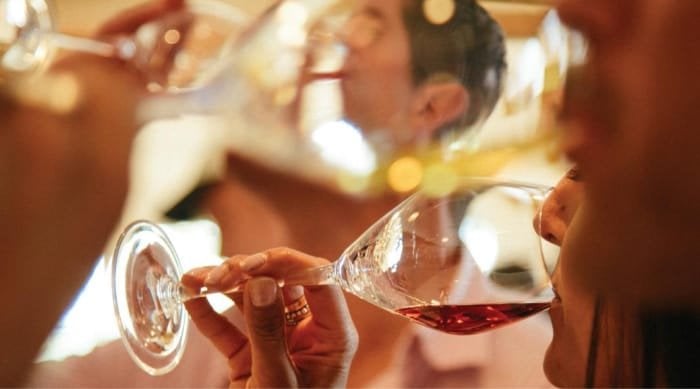
Ice wine is a sweet wine with high sugar levels. It contains strong notes of citrus, honey, stone fruit (such as peach and dried apricot), and tropical fruit.
White ice wine retains the freshness of its base grape. Whereas red ice wine has fruit flavors like strawberry and some light spice.
They are generally low in tannins, with ABV levels varying from region to region.
How To Drink and Serve Eiswein?

If you’re new to the ice wine experience, give it your full attention.
First, observe its color and texture. Swirl it for about 10 seconds to release its aroma. And when you take the first sip, take in the wine’s acidity, tannins, and sweetness before relishing it’s fruit flavors.
The best way to enjoy ice wine at its finest is to serve it right in your best glasses (think exquisite Riedel glassware!) For this, pour it in a wide mouth white wine glass that allows the wine to breathe. Refrigerate the wine for some time before drinking and serve it chilled at around 10-12°C (50-54°F).
Dessert wines like Eiswein pair best with food that are only as sweet or less sweet than them. Pairing it with a dessert that’s sweeter than the ice wine can leave you with a bitter aftertaste.
That’s why wine experts suggest pairing ice wine with simple desserts like vanilla ice cream, yogurt panna cotta, or creme brulee.
If you want something more textured and rich, go for a chocolate mousse or a cheesecake.
In savory pairings, ice wine goes best with soft cheeses, seafood, and spicy cuisines like Thai, Indian, or Mexican.
Does this make you crave some delicious ice wine?
Try out a few bottles from this list of the 10 best ice wines of 2024.
10 Best Ice Wines Of 2024
Globetrot (virtually) around ice wine regions with this hand picked list of top ice wines!
1. 2012 Egon Muller Scharzhofberger Riesling Eiswein
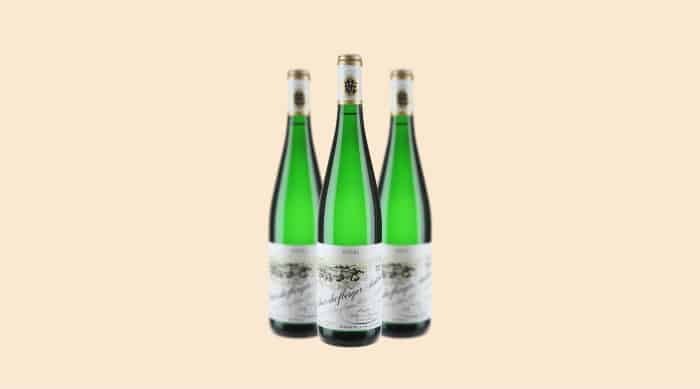
Egon Muller’s estate, in the heart of Mosel wine country, has been churning out fine German wine for more than 200 years. And Riesling wines are their crowning glory. Their 2012 batch of this German Eiswein, classified as ‘spatlese’ or late harvest, continues the tradition of zesty and peachy sweet wines.
Pick this snappy, acidic wine for a complex bouquet of green apple and citrus.
Price of 2012 Egon Muller Scharzhofberger Riesling Eiswein: $1,769
2. 1983 Joh. Jos. Prum Wehlener Sonnenuhr Riesling Eiswein

The Prüm family is famous for their sweet Auslese wines made with botrytis affected ripe grapes that are naturally high in alcohol.
Their 1983 Eiswein is a rich and sweet, amber-colored wine. It has a good balance of acidity and structure and rounds its nutty flavors with a lingering finish.
Price of 1983 Joh. Jos. Prum Wehlener Sonnenuhr Riesling Eiswein: $1,393
3. 2004 Inniskillin Legacy Edition Karl Kaiser Cabernet Franc Icewine

Canada’s Niagara Peninsula is the world’s largest ice wine region. And Inniskillin is undoubtedly its most famous winery.
This medium to full-bodied wine, however, steps outside the traditional flavors. It has cranberry and apple notes, and pops with a sweetness of bubblegum!
Price of 2004 Inniskillin Legacy Edition Karl Kaiser Cabernet Franc Icewine: $377
4. 2013 Peller Estates Signature Series Brix 50 Vidal Blanc Icewine
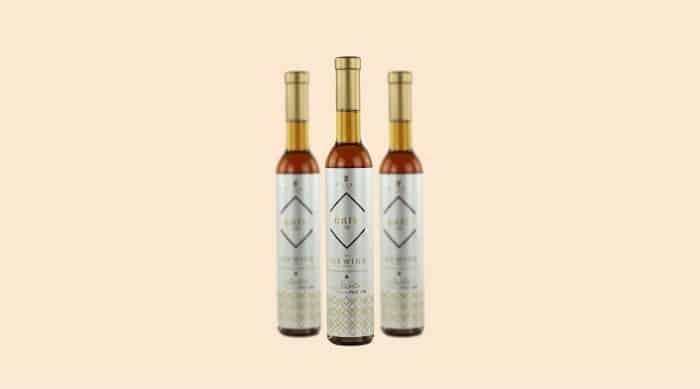
Founded by Andrew Peller, a Hungarian immigrant, the Peller Estates brings a European flair to their ace Canadian ice wine. Enjoy the juicy flavors of pear, peach, and candied citrus peel in the 2013 Vidal ice wine of their Signature Series.
Price of 2013 Peller Estates Signature Series Brix 50 Vidal Blanc Icewine: $1,138
5. 2016 Riverview Cellars Cabernet Franc Icewine
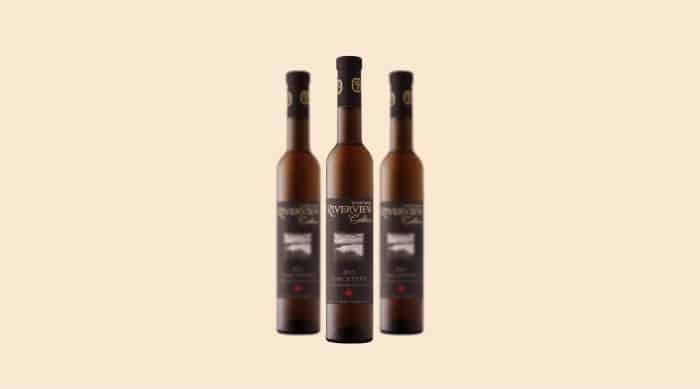
Set on the banks of Niagara wine region, Riverview Cellars is a family-run estate with a rich history of classic ice wines.
Their 2016 is a medium-bodied, well-balanced wine with the deep red color of Cabernet Franc grapes. Its richly textured strawberry notes and delicious butterscotch flavor are complemented by just a hint of lemon.
Price of 2016 Riverview Cellars Cabernet Franc Icewine: $104
6. 2017 Inniskillin Cabernet Franc Sparkling Icewine
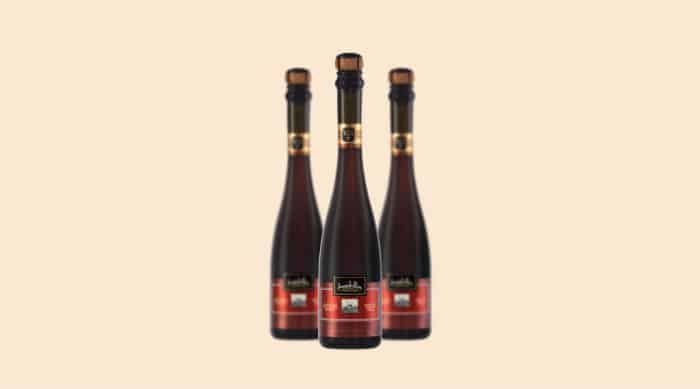
Bubbles in an ice wine? A wine lover could not have asked for a better combination. And Inniskillin delivers!
Strawberries, raspberries, and rhubarb truly sparkle in this delicious combination. You’ll also taste some chocolate and raisins in this jammy wine.
Price of 2017 Inniskillin Cabernet Franc Sparkling Icewine: $293
Check out the different types of sparkling wines as well:
- Sparkling Red Wine (Different Styles, Best Wines to Buy 2024)
- Pink Champagne (12 Best Wines, Pricing, How to Buy)
- Cristal Champagne: All About it & How to Buy One
7. 2010 Weingut Donnhoff Oberhauser Brucke Riesling Eiswein
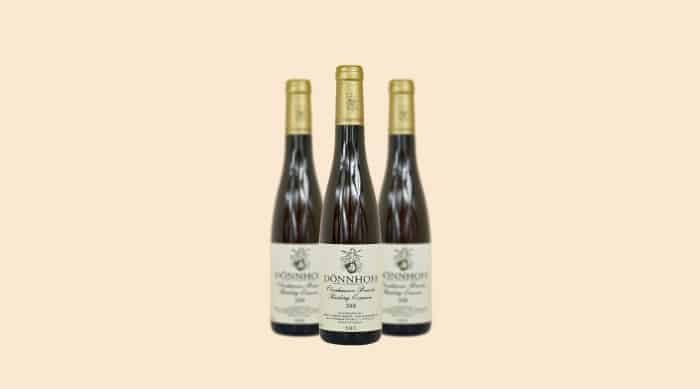
Based in Nahe, Rhineland, Donnhoff is only one of the three German winemakers to receive a perfect 100 from Robert Parker. And the 2010 vintage is one of its prestigious batches to win this rare honor.
This exquisite ice wine balances fruity sweetness with racy acidity, rounded up by a smooth and lingering finish.
Price of 2010 Weingut Donnhoff Oberhauser Brucke Riesling Eiswein: $364
8. 2002 Dr. Loosen Erdener Treppchen Riesling Eiswein Goldkapsel

Dr. Loosen is in the Erden township of Mosel, and is a prestigious and influential winemaker from Germany. They’re famous for their botrytized varieties of sweet Auslese, Beerenauslese, and Trockenbeerenauslese wines.
This peachy and tangy vintage is full of mineral flavors and finishes with hints of vanilla and sweetness.
Price of 2002 Dr. Loosen Erdener Treppchen Riesling Eiswein Goldkapsel: $718
9. 2006 Weingut Nigl Riesling Trockenbeerenauslese
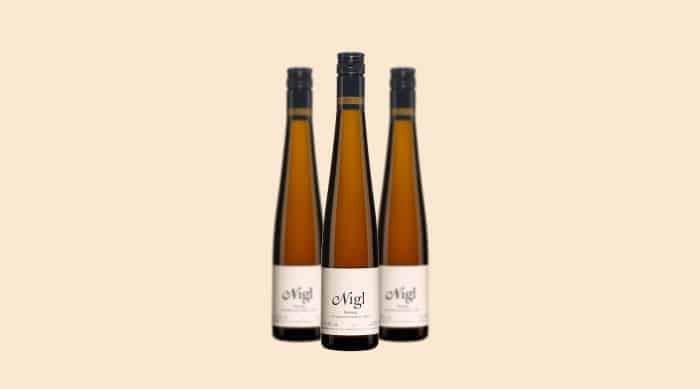
Weingut Nigl’s reputation rests firmly on their fine wines made with authentic Austrian varietals like Grüner Veltliner and Resiling.
This lush dessert wine comes from parts of lower Austria bordering Slovakia. It contains tangy acidity peach, apricot, and honeyed notes.
Price of 2006 Weingut Nigl Riesling Trockenbeerenauslese: $118
10. 2005 Casa Larga Fiori delle Stelle Cabernet Franc Ice Wine
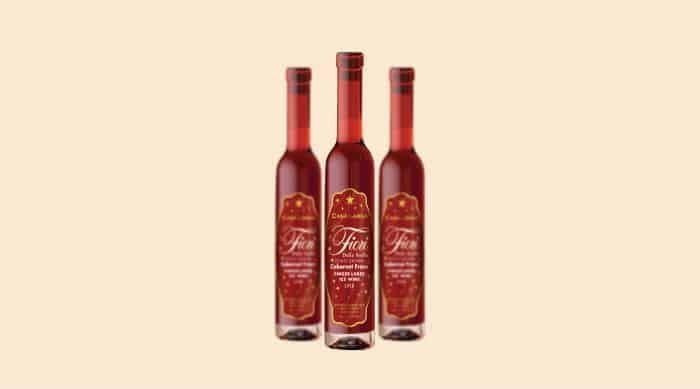
In the cool climate of the Finger Lakes region (in upstate New York), Casa Larga estate makes classic Riesling based ice wines.
Their 2005 Cabernet Franc tastes of pear and tropical fruits like pineapple. Enjoy the earthy notes in this excellent wine with blue cheeses or a delicate dessert.
Price of 2005 Casa Larga Fiori delle Stelle Cabernet Franc Ice Wine: $120
How To Buy The Best Sweet Wines
Dessert wines are the perfect way to wind up a luxurious dinner. And sometimes, they’re a dessert all by themselves!
But collecting the best ice wine or sweet wines is not without its own set of challenges.
Finding the right brands. Authenticating the bottles. Storing them the right way. You’ll need to spend time and money, every step of the way.
Want to avoid this complicated route? Your best bet would be to buy wines through a world-class wine investment company like Vinovest.
Invest In Sweet Wines Through Vinovest

Vinovest is an online wine investment company that helps you buy, store, and sell the best from around the world.
You can build your Vinovest portfolio with the finest, authentic bottles without breaking a sweat, and watch your investment grow over the years!
How Does It Work?
Follow these simple steps to start investing today.
- Sign up
- Provide information about your investment preferences and risk appetite.
- Add a $1,000 (minimum investment) to your account.
- Build your portfolio and watch it grow over time.
Benefits
Wine investment with Vinovest is a breeze because of these features.
Easy buying and selling
Vinovest’s AI-based platform makes scouting for the best wines effortless - be it from Rheingau, Napa Valley, Chile, or Michigan.
Best prices
Vinovest gets you the best wholesale prices by sourcing wine directly from wineries, wine exchanges, and merchants.
Provenance and authenticity
No need to triple check each bottle in your case of Sauternes wine! Vinovest will authenticate every purchase and give you detailed information on its provenance and storage condition with the previous owners.
Curated portfolio
Vinovest’s Sommeliers, data scientists, and proprietary financial models design a wine portfolio that fits your investment needs like a glove.
Optimal storage
No need to buy a bigger wine fridge for your growing Vidal icewine collection. Vinovest stores your bottles in bonded warehouses in the right light, humidity, and temperature conditions.
Insurance
Your wine collection will be covered for breakage and loss with Vinovest’s comprehensive insurance policy that covers both breakage and loss.
Access to a global network
You’ll get access to a global network of wine lovers and experts from Burgenland to Ontario, including private, exclusive sellers.
Ownership
You own all the bottles in your Vinovest portfolio and can choose to drink them or sell them whenever you want.
Easy delivery
Get your precious Chateau Chantal ice wine or German ice wine delivered to your doorstep in case you want to raise a toast at a spring party.
Conclusion
Whether it’s a laid back summer afternoon or a joyous celebration, ice wine is the perfect drink for all wine lovers. Some of them also make a worthy investment that’ll stand the test of time.
So if you enjoy its mouth-watering, fruity flavour, the easiest way to start collecting ice wine or sweet wine bottles is to buy them through Vinovest’s powerful wine investment platform.
So sign up for Vinovest and get started on your wine investment journey today.
